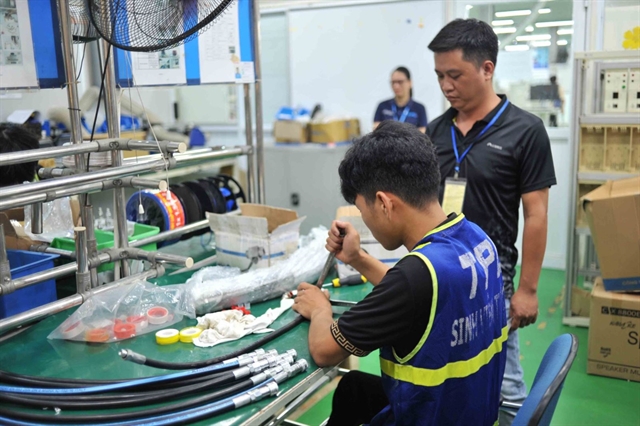 Society
Society

 |
| A training session at a vocational school. — VNA/VNS Photo |
HÀ NỘI — Technical schools and junior colleges in Việt Nam have begun taking admission applications for the new school year though the process is taking longer than usual as numbers depend on university enrollment.
Enrolling in the electronic engineering major at Hà Nội College of Electronics and Electro-refrigeratory Technics (HCEET), Ngô Quang Đại, a new high school graduate said: “My brother also went to this school, and two years later he got a job right after graduation.
“I have enrolled in this school so that I too can find a job immediately after I graduate.”
Phùng Quốc Hòa, a father whose son is applying to the same school, said that his son got quite a high score in the national high school graduation exams and wants to study electrical engineering and electro-refrigeratory technics.
After doing research, the family decided on HCEET.
Hòa said: “His major choice partly depends on his ability and passion, but our family sees that there is a huge demand for talents in this industry on the labour market.
“Junior colleges focus on practical experience and after graduation, he could work in a company or open his own business at home.”
According to HCEET vice principal Nguyễn Thị Hằng Nga, the school plans for 500 admissions for junior college level and 250 for intermediate level.
By Monday this week, the number of applications received accounts for about half of these figures, respectively.
Hà Nội Tourism Vocational Intermediate School (HHTC) has only received 40 enrolments out of its 100 planned admissions.
Trương Tường Lân, the school principal said: “Most of the students who decide to go to intermediate school have a clear career orientation from the start.
“Based on the applications we receive, some have even finished university but need practical skills, and so they return to vocational schools to meet the requirements of recruiters.”
Universities are expected to complete admission on September 17, and therefore the admission period of junior colleges and intermediate schools will run until the end of the month.
Lân added that while the school admits students all year round, the peak period still falls in August and September.
After September 17, students will make a final decision on whether to choose vocational training or university.
There are also cases where they choose to go to university and don’t think it fits them, and therefore switch to junior colleges or vocational schools.
Statistics from several colleges reveal that because university entrance is easier compared to the previous year, most high school graduates have had two to three acceptance papers from universities.
Most of those who choose junior colleges have financial difficulties or want to finish school quickly so they can begin work.
According to Phạm Vũ Quốc Bình, deputy director general of the Directorate of Vocational Education (under the Ministry of Labour, Invalids and Social Affairs), with the post-pandemic socio-economic recovery, many students are more interested in sectors such as tourism, healthcare, logistics, engineering, information technology, software engineering and high-quality agriculture.
In reality, schools with a good reputation and a commitment to students’ graduation are seeing good progress in enrolment.
Data from recruiters show the demands for human resources account for 21.84 per cent for those with a university degree, 18.46 per cent for junior college, 25.88 per cent for intermediate school, 20.4 per cent for pre-intermediate school, and 3.42 per cent for untrained workers.
Meanwhile, of more than 940,000 people are planning to apply to universities after the national exams, while 34.5 per cent, or 325,000 students, did not submit their applications.
Mạc Quốc Anh, vice chairman of Hà Nội Association of Small and Medium Enterprises said: “Although the comparison between enrolments and recruitment demands is only relative, it more or less shows the gap between training and employment.
“This means that approximately 30 per cent of university graduates will not work in the industry they are trained in, or will have to re-learn from scratch at the workplaces.”
Anh added that the number of 325,000 deciding not to apply for universities could translate to a positive response to the demands for skilled workers in the general and intermediate-level labour market.
Many students consider their family circumstances and academic ability in choosing their major.
Currently, the primary recruiters are private or FDI (foreign direct investment) companies, which require advanced skills and practical experience. — VNS